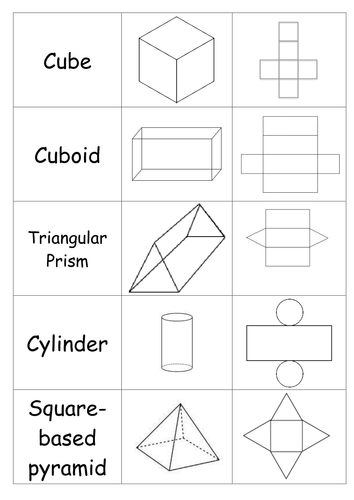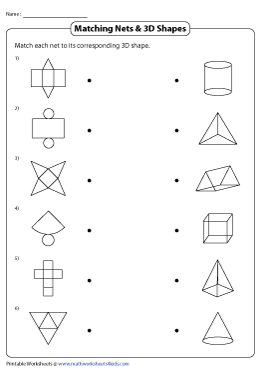Materials Needed
Mystery box with 3D shapes
Cardstock/paper nets for folding
Scissors, glue/tape
Graph paper
Markers/crayons
Ruler
Multimedia projector
Cromebooks, teacher's blogsite
Students I want you to tell me what you understand by Nets of solids. ( Discussion will be ensued about where they have ever seen these nets and how they can be created.) Let us take a look at the definition below.
FOLLOW UP PRACTICE EXERCISES
Grade Level: 6
Strand: Geometry
Topic: Nets of Solids
Focus Question: What are the properties of solid figures?
Duration: 1 Hour
Objectives:
By the end of the lesson, students should be able to:
-
Recognize faces, edges, and vertices of solids and classify solids according to the number and shape of their faces.
-
Describe, design, or create three-dimensional shapes.
-
Describe the physical world in terms of geometric concepts and talk about mathematical findings.
5E Lesson Plan Model
Engage (10 minutes)
Activity: Solid Shapes Mystery Box
-
Place several 3D solids (cube, prism, pyramid, cylinder, etc.) in a box or bag.
-
Let students reach in, feel one without looking, and describe the shape based on touch (faces, edges, vertices).
-
Ask:
“What did you feel?”
“How many faces do you think it has?”
“Can you guess the shape?”
Purpose: Activates prior knowledge of 3D shapes and introduces geometric properties (faces, edges, vertices).
Explore (15 minutes)
Activity: Build and Examine Nets
-
Distribute cut-out nets (paper or cardstock) of various solids (cube, triangular prism, square pyramid).
-
In pairs, students fold and construct the 3D shapes.
-
Guide them to count and record:
-
Number of faces, edges, and vertices
-
Shape of each face
-
STEM Integration:
-
Discuss real-life applications: packaging design, architecture, 3D modeling.
-
Students briefly research (or are shown pictures of) how engineers use nets to design 3D objects.
Explain (10 minutes)
Activity: Anchor Chart & Discussion
-
Create a class chart listing solids with their number of faces, edges, vertices, and face shapes.
-
Use visual models (projected diagrams or digital tools) to match solids with their nets.
-
Highlight how nets relate to surface area and structure in real-world designs.
Vocabulary: Face, edge, vertex, net, solid figure, prism, pyramid, cylinder, cone, cube.
Elaborate (15 minutes)
Activity: Design Your Own Net (Creative STEM Task)
-
Students select a real-world object (e.g., cereal box, tent, can) and sketch or build a net for it.
-
Use graph paper or a net template app/tool to help them design accurately.
-
Share and explain their creations in small groups.
Complete activities on teacher's blogsites on their chromebooks
Differentiated Learning:
-
Tier 1 (Support): Pre-cut nets to fold and label
-
Tier 2 (On-Level): Complete a partially drawn net and describe the 3D object it forms
-
Tier 3 (Advanced): Create an original net for a given shape and write about its real-world application
Evaluate (10 minutes)
Three-Tier Evaluation Activity
| Tier | Task | Objective Measured |
|---|---|---|
| Tier 1: Basic | Match a net to its 3D shape and list its number of faces, edges, and vertices. | Objective 1 |
| Tier 2: Intermediate | Given a 3D shape, sketch its net and label its parts (faces, edges, vertices). | Objectives 1 & 2 |
| Tier 3: Advanced | Create and explain a real-life scenario where understanding nets is necessary (e.g., designing a gift box). Present findings to the class or in a written paragraph. | Objectives 2 & 3 |
Assessment Tools:
-
Observation checklist
-
Student-created models and nets
-
Group presentation or short written response
Closure (Optional Exit Ticket Prompt)
“What is one solid you used today? How many faces does it have, and what shapes are they?”






No comments:
Post a Comment